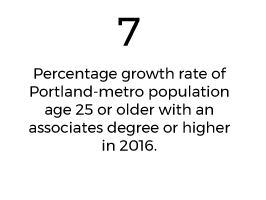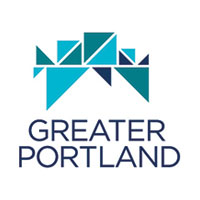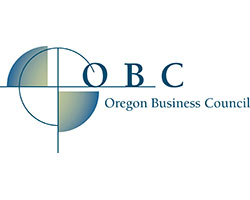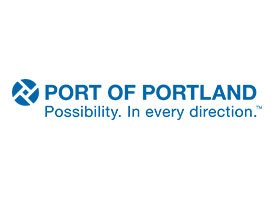PORTLAND-METRO ECONOMIC OUTCOMES
Portland-metro’s economy, by a number of indicators, remains strong. As in years past, the number of jobs grew across nearly all industries and median household incomes (MHI) grew across all races and ethnicities. However, as more people move to the region, Portland-metro is experiencing growing pains, presenting a challenge for the region that must be addressed. Because Portland-metro’s population continues to grow year after year, the challenge for local leaders becomes ensuring that the region has an adequate supply of housing, and that quality jobs are readily available for current and incoming residents.
Increasing commute times and escalating home prices are pressing challenges; people are living farther away from their place of work, and Portland-metro has a significant challenge with housing supply and affordability that will impede economic growth and opportunities for upward mobility if not addressed. Additionally, while household incomes grew across the board this year, there remains significant disparities between races, with African Americans, American Indians and Hispanic/Latinos well below white and Asian households. As the region becomes more diverse, it is critical to close this divide. Finally, even though Portland-metro continued to see job growth, the 2017 job gains represented was the slowest annual growth in five years. These hurdles can be cleared, but they must be addressed on a regional level if Portland-metro is to increase economic vitality and opportunity.
Portland-metro has shown strong growth in both population and employment. Since 2000, the Portland-metro population has grown by 25 percent. Employment growth showed a similar trend at 24 percent growth since 2000. A key challenge, however, emerged beginning in 2009 and shows no signs of abating: Housing supply is not keeping pace with population growth. See Figure 1. Until the number of housing units closes the gap with the growing population, affordability will continue to be a significant challenge for the region.
(Hover over data points for more information.)
Consistent with national trends, job growth continued in 2017, albeit at the slowest rate since 2012. See Figure 2. That 2.1 percent growth still outpaced the national average for metro areas, which was 1.5 percent. This is the seventh consecutive year that the Portland-metro region has outpaced the U.S. metro average.
(Hover over data points for more information.)
Education/health services, professional/business services and government remain the largest sources of employment for the region’s residents. Jobs in the construction, education/health services and transportation/utilities sectors grew at a faster pace than all other industries. Together, those three industries added 3,817 jobs in 2017. See Figure 3. Only mining and logging, wholesalers and uncategorized services saw decreases in employment. The construction industry grew 11 percent in the past year alone; and a stunning 51 percent in the past seven years. Since 2010, the leisure/hospitality and professional/business services sector grew at rates just below construction, at 22 percent and 31 percent, respectively. See Figure 4. The fact that almost all industries added jobs is a sign of prosperity, but these numbers also underscore the need to continue investing in development and a skilled regional workforce.
(Hover over data points and click tabs for more information.)
As MHI has increased throughout the region, all races and ethnicities saw gains over the past year. However, communities of color in the Portland-metro region have not equally benefited from the economic growth. See Figure 5. While African American households continue to suffer from stagnant incomes, the 2016 uptick in MHI is a promising sign for families who have not seen meaningful increases in incomes since the recession, landing at $37,452. Hispanic/Latino households remain well below white and Asian households. White household incomes grew the most, from $67,376 in 2015 to $71,859 in 2016. Though the population size is too small to meaningfully track changes over time, American Indian/Alaska Native MHI is also well behind white households at $43,187. Coupled with a rising cost of living, these disparities may increase geographic and economic displacement among the region’s minority populations unless this inequality is addressed.
(Hover over data points for more information.)

Prosperity & Productivity

Opportunity & Affordability

Workforce & Investment Climate
What this means
This 2017 Economic Check-Up provides a more detailed and nuanced approach to evaluating the strengths and weaknesses of Portland-metro relative to comparator regions. The broader set of economic indices used allows us to better identify areas that require further attention in the region, as well as areas where Portland excels.
Among the six regions, Portland-metro ranks fourth overall across all economic indicators in each of the three categories: 1) prosperity and productivity, 2) opportunity and affordability, and 3) workforce and investment climate. Portland-metro excels in some areas; however, the region also underperforms in a number of categories. Austin, Salt Lake City and Portland are most tightly clustered together, ranking No. 2, No. 3 and No. 4, respectively, behind Seattle, out of the six comparator regions based on a broad set of economic, demographic and affordability measures.
Portland-metro continues its strong run during this prolonged economic expansion. Like its comparator regions, population and job growth have been well in excess of the U.S. metro average. Importantly, as the population has grown, it has also become better educated, with the share of those age 25 years and older with an associate degree or better growing faster than all comparator regions.
Highlights for Portland-metro include a recent acceleration in median household income (MHI), which grew faster than all comparator regions between 2010 and 2016. The growth in MHI is a notable bright spot in this year’s report, reflecting a reversal of the long-term trend of middle-income wage stagnation. Portland-metro also had a strong performance in all measures related to broad economic output, measured by gross metropolitan product (GMP). The strong showing in GMP is largely driven by Washington County’s semi-conductor industry.
There are two key areas that need focused attention and improvement. Housing affordability remains a significant challenge that threatens continued economic progress and opportunity. It is necessary to develop a robust response to increase housing supply commensurate with the growing population. Fully 37 percent of the region’s households were cost-burdened – paying more than 30 percent of household income on rent or mortgage – in 2016. In addition, Portland-metro ranks high as it relates to the ratio of median home prices to MHI. In both cases, Portland is tied with Seattle and well over the U.S. metro average in these measures of housing affordability.
Another area that requires attention is ensuring everyone is sharing in the economic growth and opportunity the region is experiencing. Though income inequality is less pronounced in Portland-metro relative to comparator regions, except Salt Lake City, some populations are not keeping up. African Americans, in particular, have MHI’s far below other racial groups, only recently regaining the incomes lost during the recession. Another challenge will be boosting Portland’s lackluster per capita income without exacerbating inequality, which requires wage gains across low-, middle- and high-skilled work.
The goal of the Value of Jobs coalition is to promote private-sector job growth and broadly shared economic prosperity. This report makes clear the imperative to focus on affordability and growing jobs across the board for the region to continue its strong economic performance. As Portland-metro continues to grow, this annual report will provide a key tool for policymakers and stakeholders to identify areas to focus on to ensure a world-class region with opportunities for all.










